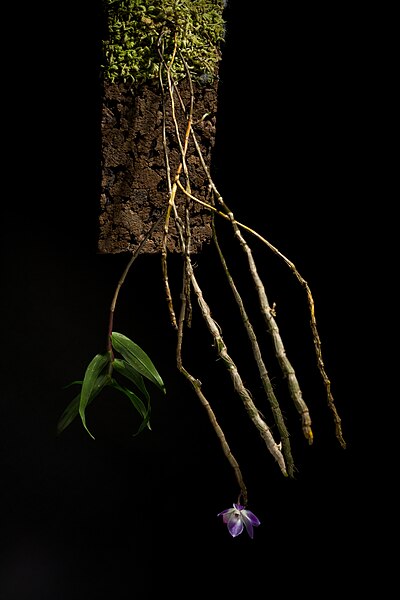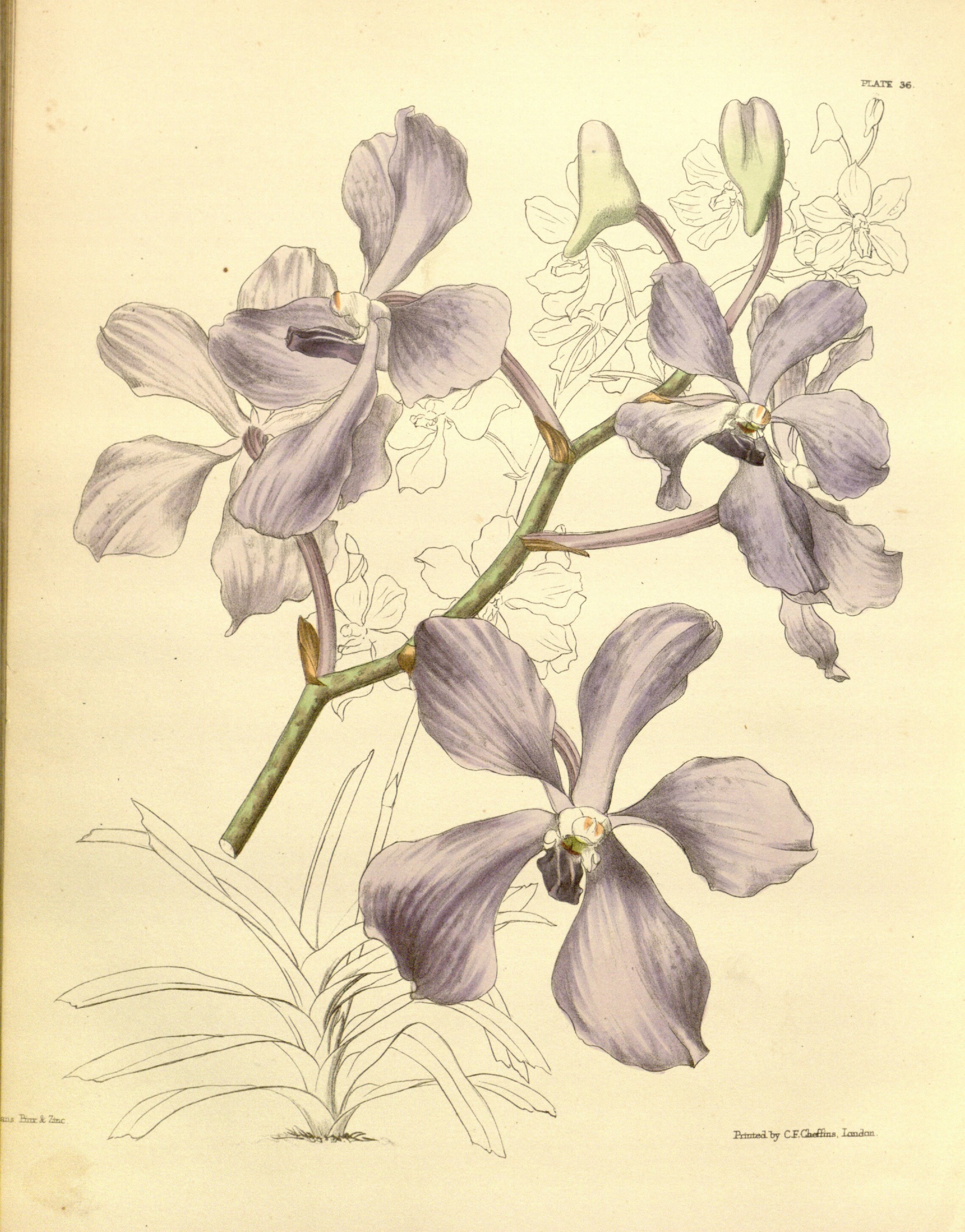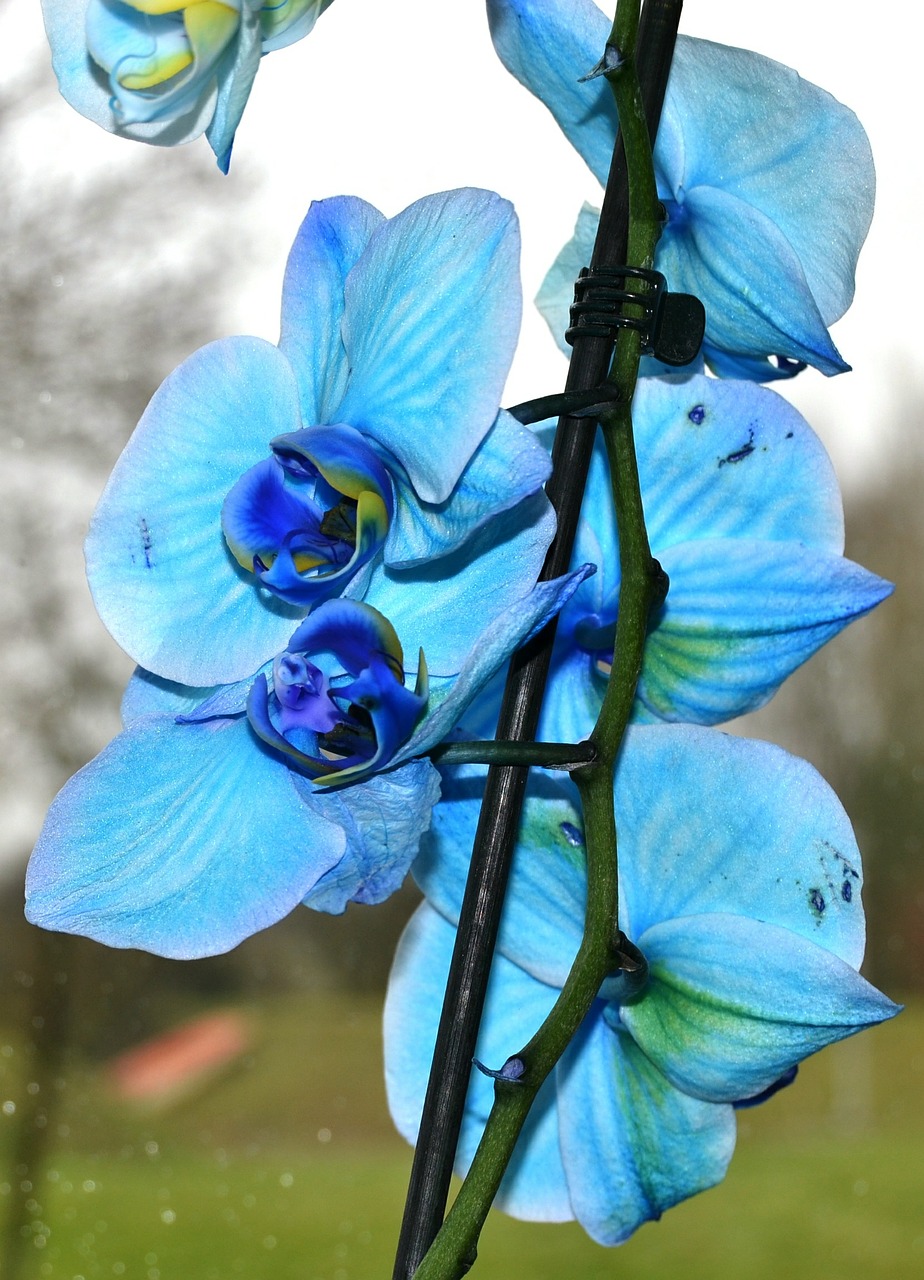Following my last post, I wanted to assure you of the aforementioned 'naturally-occurring blue orchids'. It is interesting how alluring the color blue is. It may come as no surprise to you that blue is "the world's favorite color" according to a survey conducted by YouGov
But what makes blue so beloved? I've always heard of color studies suggesting that blue is associated with comfort. My personal theory is that because blue occurs less often in nature (aside from the sky and the ocean, of course), we see it as a rarity and a spectacle. Anything that is blue is exciting. We surround ourselves with it by painting our walls, coloring our food, and in my earlier example-- dyeing store-bought orchids. But there is something so elegant about the way blue is presented [naturally] in living beings. From the dim light of the glow-worm to the eerily vibrant poison dart frog.


Blue is especially exciting when you spot it on an orchid, at least in my opinion. Although I have never been to one, I love imagining a scenario where I am walking through a rainforest, and my entire field of vision is filled with green from the canopy to the dense underbrush. And there I spot the faintest hue of blue, but it stands out like a sore thumb. I'm even more delighted to find out that this blue I have spotted is occurring on an orchid! Blue is uncommon among living things but it is exceptionally rare on orchids (especially epiphytic ones!!). So without further ado, let's take a look at some of these remarkable plants!
*Disclaimer* Many of the examples I pulled have a more lavender-blue than a 'true blue'. I'm not sure if any examples of teal-blue or electric-blue exist among orchids that have been discovered. But I can say with certainty that these orchids are downright beautiful and that I could stare at them for hours.
1.) Pheladenia deformis
Also referred to as the blue beard orchid, pheladenia deformis is an Australian native. Unlike the other orchids discussed so far, the blue beard is a terrestrial grower. This means that this orchid grows in the ground, and not on other plants or surfaces like rocks. According to PlantNET, they can be found growing among Australian native shrubs-- suggesting a preference for partial shade.


It's no secret why they call this orchid 'blue beard', with its cluster of dark purple fringe at the end on the callus, the flower appears to have stubble! I love the understated beauty of this orchid. The plant itself is not very big, not reaching more than 6 inches in height. The leaves are slender and unassuming, and even when the plant is in bloom-- the flowers are solitary. But when looking at the finer details of the flower you find that gorgeous blue, those sparkly white trichomes, and (what I assume to be) that deep red column. Sources have also noted that the flowers possess a slightly sweet fragrance. All I know is, I have to visit Australia someday.
2.) Dendrobium victoria-reginae
Dendrobium victoria-reginae, or Queen Victoria's orchid, is an epiphytic species native to the highland forests of the Philippines, where they receive dappled light through the canopy, cool temperatures and plenty of humidity.


While this orchid leans more towards the purple side, especially while the buds are still forming, it is undeniably close to blue. Not to mention, this particular species is available on the market, making it a must for any orchid collector.
3.) Thelymitra crinita
Thelymitra crinata, also known as the Blue Lady Orchid, is a Western Australian terrestrial grower. This is probably the closest to a true-blue orchid that will be found on this list. Why it is not found at the top of the list is because I find the shape not as interesting as the p. deformis and I enjoy epiphytes more (hence why d. victoria-reginae is found above as well). I can understand why many enjoy the symmetry and fullness of the flowers, as well as the abundance of them on each stalk. The genus Thelymitra is unique to Australia, like many of the plants found there. This genus is referred to as the "sun orchids", because their flowers develop and open fully on warm, sunny days.

 4.) Vanda coerulea
4.) Vanda coerulea
Vanda coerulea, or the blue vanda as it is more commonly known, is a very popular epiphytic orchid native to parts of Myanmar, China, India, and Thailand. Known for it's widely sold and distributed hybrids, the vanda coerulea is highly endangered in its native range. Their habitat is quickly being destroyed and the plants are being uprooted and sold in street markets. The man-made hybrids that dominate the orchid market do not serve as a replacement for this vanda's natural population. Pictured below is an accurate depiction and photograph of a naturally occurring blue vanda.


And here is an example of one of the more popular hybrids being sold today. As you can see, the petals are wider and the color more vibrant, giving a fuller, more appealing look. The plants don't even look like the same species.

As you can see there are orchids of all shapes and sizes in some form of blue. Obviously, blue orchids are not limited to the ones on this list. These are just my personal favorites. So I encourage you to explore, find your own favorites- conduct research! One day I am determined to go to Australia and see some of their wonderful terrestrial orchids. Who knows, maybe I'll get grant funding to do some conservation work. Anyways, I'll keep you posted!
Honorable Mentions:
Neofinitia falcata (blue variety)- sky blue/ pale lavender in color. Native to Asia.
Thelymitra cornicina- similar to T. crinata but more purple. Native to Australia.
Disa graminifolia- white, blue, and purple in color. Terrestrial. Native to Africa.
Caladenia gemmata- vibrant blue-lavender in color. Terrestrial. Native to Australia.
Cleisocentron gokusingii- pale blue and dark purple. Widely sold hybrids. Native to the Himalayas.
Sources:
https://today.yougov.com/topics/international/articles-reports/2015/05/12/why-blue-worlds-favorite-color
https://commons.wikimedia.org/wiki/File:Nz_glowworm.jpeg
https://www.wallpaperflare.com/selective-focus-photography-of-blue-frog-exotic-close-terrarium-wallpaper-zeijx
https://www.flickr.com/photos/jean_hort/42798341545
http://plantnet.rbgsyd.nsw.gov.au/cgi-bin/NSWfl.pl?page=nswfl&lvl=sp&name=Pheladenia~deformis
https://vicflora.rbg.vic.gov.au/flora/taxon/38bd131c-deb8-48db-84a0-3c18c388beaf
https://akatsukaorchid.com/content/DenVictoria.pdf
https://commons.wikimedia.org/wiki/File:Dendrobium_victoriae-reginae_Orchi_045.jpg
https://commons.wikimedia.org/wiki/File:Dendrobium_victoriae-reginae_Loher,_Gard._Chron.,_ser._3,_21_399_(1897)_(47826540862).jpg
https://commons.wikimedia.org/wiki/File:Vanda_coerulea_Paxton_036.jpg
https://commons.wikimedia.org/wiki/File:Vanda_coerulea_Orchi_6052.jpg
https://www.flickr.com/photos/alexlomas/2943608475/
https://www.pacificbulbsociety.org/pbswiki/index.php/Thelymitra
https://www.flickr.com/photos/66951228@N07/6725026393
https://commons.wikimedia.org/wiki/File:Thelymitra_crinita_gnangarra_06.JPG
Mohammad Musharof Hossain "Therapeutic orchids: traditional uses and recent advances — An overview", Department of Botany, University of Chittagong, Chittagong 4331, Bangladesh.
Linked pdf
Plant Cell, Tissue and Organ Culture 76: 289–293, 2004.
© 2004 Kluwer Academic Publishers. Printed in the Netherlands.
Linked pdf
Christophe P., 2012.- La variabilité des formes cultivées de Vanda coerulea. L'Orchidophile 197 : 00.
Linked pdf















































![Sabah Borneo, Malaysia] Phalaenopsis bellina (Rchb.f.) Ch… | Flickr](https://live.staticflickr.com/65535/48320200326_0fa1afc915_b.jpg)






